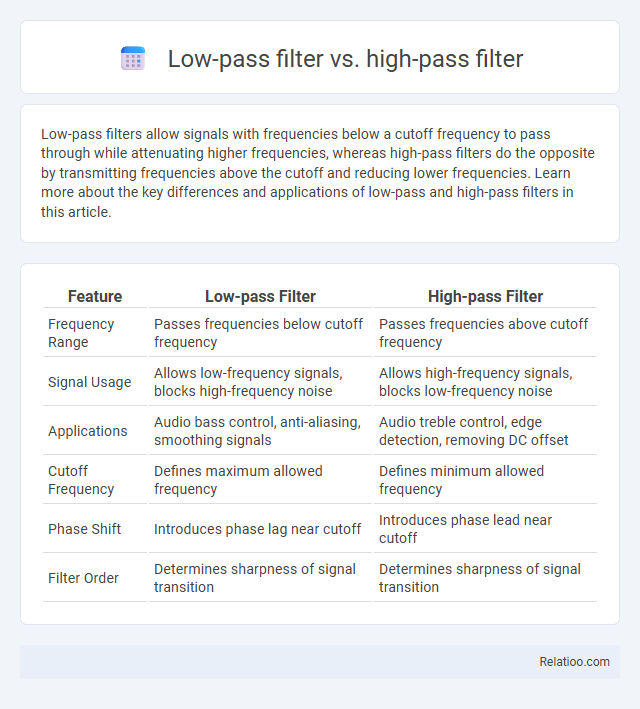Low-pass filters allow signals with frequencies below a cutoff frequency to pass through while attenuating higher frequencies, whereas high-pass filters do the opposite by transmitting frequencies above the cutoff and reducing lower frequencies. Learn more about the key differences and applications of low-pass and high-pass filters in this article.
Table of Comparison
| Feature | Low-pass Filter | High-pass Filter |
|---|---|---|
| Frequency Range | Passes frequencies below cutoff frequency | Passes frequencies above cutoff frequency |
| Signal Usage | Allows low-frequency signals, blocks high-frequency noise | Allows high-frequency signals, blocks low-frequency noise |
| Applications | Audio bass control, anti-aliasing, smoothing signals | Audio treble control, edge detection, removing DC offset |
| Cutoff Frequency | Defines maximum allowed frequency | Defines minimum allowed frequency |
| Phase Shift | Introduces phase lag near cutoff | Introduces phase lead near cutoff |
| Filter Order | Determines sharpness of signal transition | Determines sharpness of signal transition |
Introduction to Filters
Filters play a crucial role in signal processing by selectively transmitting signals based on frequency. A low-pass filter allows signals with frequencies below a certain cutoff to pass while attenuating higher frequencies, making it ideal for removing high-frequency noise. Conversely, a high-pass filter permits frequencies above the cutoff, blocking lower frequencies to isolate specific signal components; understanding these filters enables you to tailor signal processing effectively.
What is a Low-Pass Filter?
A low-pass filter allows signals with frequencies below a specified cutoff frequency to pass through while attenuating higher frequencies, making it essential for removing high-frequency noise from audio or sensor data. In contrast, a high-pass filter permits frequencies above its cutoff frequency to pass, blocking lower frequencies and is often used for eliminating baseline drift or low-frequency interference. Filters, in general, are electronic circuits or algorithms designed to selectively pass or reject specific frequency ranges to improve signal quality or extract relevant information.
What is a High-Pass Filter?
A high-pass filter allows frequencies higher than its cutoff frequency to pass through while attenuating lower frequencies, effectively removing unwanted low-frequency noise or signals. You can use high-pass filters in audio processing to eliminate hum or rumble, enhancing clarity by preserving treble components. In contrast, low-pass filters permit frequencies below the cutoff frequency, useful for smoothing signals, and the general term "filter" refers to devices designed to selectively control frequency ranges for various applications.
Working Principles: Low-Pass vs High-Pass
Low-pass filters allow signals with frequencies below a certain cutoff to pass while attenuating higher frequencies, effectively reducing noise and smoothing signals. High-pass filters work oppositely by allowing frequencies above the cutoff point while blocking lower frequencies, making them ideal for removing unwanted low-frequency components like hum or rumble. Understanding these working principles helps you select the right filter to enhance signal quality based on your frequency requirements.
Frequency Response Comparison
Low-pass filters allow frequencies below a specified cutoff to pass while attenuating higher frequencies, making them ideal for reducing noise and smoothing signals. High-pass filters perform the opposite function by passing frequencies above the cutoff frequency, effectively removing low-frequency components such as DC offsets or rumble. Understanding your system's frequency response helps select the appropriate filter type to target desired signal ranges and optimize overall performance.
Applications of Low-Pass Filters
Low-pass filters are essential in applications such as audio processing, where they remove high-frequency noise to improve sound quality, and in image smoothing to reduce detail and noise. Unlike high-pass filters, which emphasize edges and fine details by allowing high frequencies to pass, low-pass filters help Your system capture underlying trends by attenuating rapid fluctuations. General filters encompass these types and are tailored to specific frequency ranges, but low-pass filters are particularly crucial in signal conditioning and noise reduction tasks.
Applications of High-Pass Filters
High-pass filters are essential in audio processing to remove low-frequency hums and rumbles, ensuring clearer sound quality in recording studios and live performances. They also play a crucial role in image processing to enhance edges and details by blocking low-frequency color gradients. Your electronic devices rely on high-pass filters to protect circuits by eliminating unwanted low-frequency noise while allowing higher frequencies to pass through effectively.
Key Benefits and Drawbacks
Low-pass filters allow frequencies below a cutoff point to pass, reducing high-frequency noise and protecting your audio signal from distortion but may cause loss of sharpness and detail. High-pass filters block low-frequency sounds, preventing rumble or hum and improving clarity, though they can remove essential bass elements from your mix. Filters generally provide frequency selection control, enhancing signal quality tailored to your needs, yet improper use can lead to phase issues or unintended frequency attenuation.
Choosing Between Low-Pass and High-Pass Filters
Choosing between low-pass and high-pass filters depends on the desired frequency range to preserve or eliminate; low-pass filters allow signals below a specified cutoff frequency to pass while attenuating higher frequencies, making them ideal for removing high-frequency noise. High-pass filters, conversely, allow frequencies above the cutoff point to pass and block lower frequencies, useful for eliminating low-frequency interference like hums or rumbles. Understanding the specific application requirements, such as signal type and noise characteristics, is essential for selecting the appropriate filter to optimize signal clarity and performance.
Summary and Final Thoughts
Low-pass filters allow frequencies below a cutoff point to pass while attenuating higher frequencies, making them ideal for noise reduction and signal smoothing. High-pass filters permit frequencies above a cutoff point, effectively removing low-frequency components like hum or drift in audio and sensor data. Understanding the distinct frequency responses and applications of low-pass and high-pass filters is crucial for selecting the right filter for signal processing tasks.

Infographic: Low-pass filter vs High-pass filter
 relatioo.com
relatioo.com